About Buildings Post Corona
Buildings Post Corona is a collaborative project between Chalmers, KTH, Lund University and Umeå University. The project aims to support the construction sector in designing and maintaining sustainable buildings with a healthy and good indoor environment. Something that has proven to be particularly urgent in the light of COVID-19.

Background
The question of how COVID-19 is spreading is something that researchers all over the world are working on right now. It is likely that the world will also see more virus pandemics in the coming decades and the buildings being constructed today will have to take this into account.
The connection between the indoor environment, ventilation and the spread of infection is a complex area, associated with many important research issues. Common to diseases linked to viruses and bacteria is that they mainly spread indoors. The spread of the disease thus has to do with buildings in different ways, more specifically with ventilation, floor plans and the resident's behavior. Infection via air has been a crucial component for many of the plagues that have developed into pandemics such as influensa, smallpox and now COVID 19. Often, this route of infection is the most difficult to prevent. In this future perspective, there is therefore every reason to seek more knowledge about how airborne transmission in the indoor environment can be reduced.
In recent years, it has been noted that climate change is creating increasingly extreme temperature fluctuations and that the processes can be rapid. The changes in the indoor climate place new demands on existing systems for ventilation, heating and cooling in the buildings. The need for new knowledge includes both how existing buildings will be changed and how new buildings should be designed to maintain good thermal indoor climate based on different future scenarios of changing outdoor climate.
While climate change itself means that in the future measures in buildings will be required to reduce the risk of infection and to provide good indoor climate under extreme climate conditions, the use of energy and resources must be minimised in order for climate change not to accelerate even further. All proposals for measures and interventions in the buildings have a climate impact and it must be valued. This problem is characterized by a complexity that requires the simultaneous presence of several disciplines. Collaboration between researchers is important as are studies that are both theoretical and experimental. Experimental studies need to be done both in a controlled laboratory environment and in the field.
Project description
The project aims to develop sustainable methods for designing and managing sustainable indoor environments characterized by good thermal climate, with little risk of virus spread. It is carried out with an interdisciplinary approach and in collaboration between researchers and researchers. The method is based on the establishment and activation of collaboration networks. Through the breadth of expertise available at the four participating universities (Chalmers, KTH, Lund University and Umeå University), we can cover various necessary perspectives and methods needed to design a good indoor environment based on sustainability, energy use, health and infection risk.
Purpose and method
The overall purpose of the proposed research is to support the building sector for future scenarios of impending climate change; to design, build and operate buildings that are healthy, use limited resources, and are climateresilient. Previous research has identified how extreme temperatures, with periods characterized by extreme cold and heat, place completely new demands on the climate systems in the buildings. Additionally, including the perspective of changes in the Earth's ecosystem, it is found that we likely will experience new types of airborne diseases beyond the COVID-19 pandemic. Further, the escalating global increase in C O2 emissions calls for radial energy use reduction from the building sector.
The research will establish new knowledge development by applying an interdisciplinary methodology with researchers utilizing their disciplinary perspective, collaborating with stakeholders with the societal connection providing knowledge, systems, and indoor spaces. The research offers the opportunity to establish an interdisciplinary platform to obtain the new knowledge required. The methodology will utilize a collaboration network that will be established and activated. With the support of the network, the project will set up and evaluate a methodology to design sustainable buildings with healthy indoor air and minimal risk of disease transmission. The results suggest best practices for the design of future sustainable buildings with a healthy indoor environment.
Learn more about how the project started, in a conversation between Jonas Anund Vogel, director of KTH Live-In Lab, and the Society of Energy and Environmental Technology: Forskningsprojekt om Covid-19 och ventilation (Youtube) (swe)


